Comprehensive Analysis on Physicochemical Properties and Characteristic Compounds of Insect-Infested Ziziphi Spinosae Semen
Abstract
1. Introduction
2. Materials and Methods
2.1. Materials and Treatments
2.2. Quality Characters
2.2.1. Color Measurement
2.2.2. Total Flavonoid Contentf
2.2.3. Main Active Compound Content
Chromatographic Condition
Preparation of Sample Solution
Preparation of Standard Solution
Method Validation
2.3. Volatile Organic Compounds
2.3.1. Sample Preparation
2.3.2. Analysis Condition
2.3.3. Data Processing
2.3.4. Statistical Analysis
2.4. Untargeted Metabolomics
2.4.1. Preparation of Sample Solution
2.4.2. Analysis Condition
2.4.3. Data Processing
2.4.4. Statistical Analysis
3. Results
3.1. Changes in Color
3.2. Changes in TFC
3.3. Changes in Main Active Compound Content
3.4. Changes in VOCs
3.5. Metabolomic Profiling of ZSS and ZSS-Pi Samples
4. Discussion
5. Conclusions
Supplementary Materials
Author Contributions
Funding
Institutional Review Board Statement
Informed Consent Statement
Data Availability Statement
Conflicts of Interest
Correction Statement
References
- The Pharmacopoeia Commission of PRC. Pharmacopoeia of the People’s Republic of China; China Medical Science and Technology Press: Beijing, China, 2020; pp. 230–232. [Google Scholar]
- He, S.; Zhao, C.; Zhang, J.; Wang, J.; Wu, B.; Wu, C. Botanical and traditional uses and phytochemical, pharmacological, pharmacokinetic, and toxicological characteristics of Ziziphi Zpinosae Semen: A review. Evid. Based Complement. Alt. 2020, 2020, 5861821. [Google Scholar] [CrossRef]
- Li, Y.; Bi, K.; Liang, X.; Xiao, H. Analysis of fatty oil in Semen Ziziphi Spinosae by capillary gas chromatography. J. Chromatogr. Sci. 2003, 41, 41–43. [Google Scholar][Green Version]
- Cao, J.; Zhang, Q.; Cui, S.; Cui, X.; Zhang, J.; Zhang, Y.; Bai, Y.; Zhao, Y. Hypnotic effect of jujubosides from Semen Ziziphi Spinosae. J. Ethnopharmacol. 2010, 130, 163–166. [Google Scholar] [CrossRef]
- Yan, Y.; Li, Q.; Du, H.; Shen, C.; Li, A.; Pei, X.; Du, C.; Qin, X. Determination of five neurotransmitters in the rat brain for the study of the hypnotic effects of Ziziphi Spinosae Semen aqueous extract on insomnia rat model by UPLC-MS/MS. Chin. J. Nat. Med. 2019, 17, 551–560. [Google Scholar] [CrossRef]
- Liu, Z.; Zhao, X.; Liu, B.; Liu, A.; Li, H.; Mao, X.; Wu, B.; Bi, K.; Jia, Y. Jujuboside A, a neuroprotective agent from Semen Ziziphi Spinosae ameliorates behavioral disorders of the dementia mouse model induced by Aβ1-42. Eur. J. Pharmacol. 2014, 738, 206–213. [Google Scholar] [CrossRef]
- Xiao, F.; Shao, S.; Zhang, H.; Li, G.; Piao, S.; Zhao, D.; Li, G.; Yan, M. Neuroprotective effect of Ziziphi Spinosae Semen on rats with p-chlorophenylalanine-induced insomnia via activation of GABAa receptor. Front. Pharmacol. 2022, 13, 965308. [Google Scholar] [CrossRef]
- Xie, J.; Guo, L.; Pang, G.; Wu, X.; Zhang, M. Modulation effect of Semen Ziziphi Spinosae extracts on IL-1β, IL-4, IL-6, IL-10, TNF-α, and IFN-γ in mouse serum. Nat. Prod. Res. 2011, 25, 464–467. [Google Scholar] [CrossRef]
- Wang, D.; Ho, C.T.; Bai, N. Ziziphi Spinosae Semen: An updated review on pharmacological activity, quality control, and application. J. Food Biochem. 2022, 46, e14153. [Google Scholar] [CrossRef]
- Wang, W.; Huang, Q.; Chen, Y.; Huang, Z.; Huang, Y.; Wang, Y.; Qi, X.; Liu, Z.; Lu, L. The novel FAT4 activator jujuboside A suppresses NSCLC tumorigenesis by activating HIPPO signaling and inhibiting YAP nuclear translocation. Pharmacol. Res. 2021, 170, 105723. [Google Scholar] [CrossRef]
- Chen, Y.; Lee, C.; Huang, K.; Kuan, Y.; Chen, M. Prescription patterns of Chinese herbal products for patients with sleep disorder and major depressive disorder in Taiwan. J. Ethnopharmacol. 2015, 171, 307–316. [Google Scholar] [CrossRef]
- Zhao, J.; Song, C.; Ma, L.; Yan, X.; Shi, J.; Hao, C. The impacts of climate change on the potential distribution of Plodia interpunctella (Hübner) (Lepidoptera: Pyralidae) in China. Insects 2022, 13, 636. [Google Scholar] [CrossRef]
- Mbata, G.N.; Warsi, S.; Payton, M.E. Influence of temperature and photoperiod on the fecundity of Habrobracon hebetor Say (Hymenoptera: Braconidae) and on the paralysis of host larvae, Plodia interpunctella (Hübner) (Lepidoptera: Pyralidae). Insects 2021, 12, 753. [Google Scholar] [CrossRef] [PubMed]
- Razazzian, S.; Hassani, M.R.; Imani, S.; Shojai, M. Life table parameters of Plodia interpunctella (Lepidoptera: Pyralidae) on four commercial pistachio cultivars. J. Asia-Pac. Entomol. 2015, 18, 55–59. [Google Scholar] [CrossRef]
- Phillips, T.W.; Throne, J.E. Biorational approaches to managing stored-product insects. Annu. Rev. Entomol. 2010, 55, 375–397. [Google Scholar] [CrossRef]
- Cheng, Y.; Liu, Z.; Yang, J.; Zhao, H.; Chao, Z. Metabolomics analysis of physicochemical properties associated with quality deterioration in insect-infested hawthorn berries. Food Chem. 2024, 459, 140374. [Google Scholar] [CrossRef] [PubMed]
- Cheng, Y.; Liu, Z.; Xu, B.; Song, P.; Chao, Z. Comprehensive metabolomic variations of hawthorn before and after insect infestation based on the combination analysis of 1H NMR and UPLC-MS. Current Res. Food Sci. 2023, 7, 100616. [Google Scholar] [CrossRef]
- Cheng, Y.; Shen, Y.; Liu, Z.; Zhao, H.; Yang, J.; Wang, F.; Chao, Z. Comprehensive comparison of metabolomic and flavor profiles in dried jujube fruits with different infestation levels. Food Biosci. 2025, 65, 106065. [Google Scholar] [CrossRef]
- Wang, S.; Luo, L.; Zhang, R.; Guo, K.; Bai, S.; Qin, D.; Zhao, Z. Comparison of edible yield and quality of female Chinese mitten crab between two-year-old and three-year-old. J. Food Compos. Anal. 2022, 112, 104687. [Google Scholar] [CrossRef]
- Huang, X.; Tu, Z.; Liu, W.; Wu, C.; Wang, H. Effect of three culture patterns on quality changes of crayfish meats during partial freezing storage. Food Chem. 2023, 414, 135683. [Google Scholar] [CrossRef]
- Liu, X.; Ou, H.; Zuo, J.; Gregersen, H. Supercritical CO2 extraction of total flavonoids from Iberis amara assisted by ultrasound. J. Supercrit. Fluid. 2022, 184, 105581. [Google Scholar] [CrossRef]
- Cheng, Y.; Wu, C.; Liu, Z.; Song, P.; Xu, B.; Chao, Z. Evaluation and optimization of quality based on the physicochemical characteristics and metabolites changes of Qingpi during storage. Foods 2023, 12, 463. [Google Scholar] [CrossRef] [PubMed]
- Liang, X.; Zhang, Z.; Yan, L.; Ding, B.; Bai, J.; Yang, J.; Liu, H. Discrimination and Characterization of Volatile Compounds Variations during Ghee Fermentation Using GC–MS and GC–IMS. Food Biosci. 2025, 106020. [Google Scholar] [CrossRef]
- Yu, Z.; Deng, J.; Ma, N.; Sun, Y.; Wang, J.; Liu, J.-M.; Zhang, Y.; Lu, Y.; Wang, S. Comparative analysis of quality, structural, and flavor alterations in chestnuts (Castanea mollissima Blume) subjected to different thermal processing techniques. Food Chem. 2025, 474, 143149. [Google Scholar] [CrossRef]
- Adelina, N.M.; Wang, H.; Zhang, L.; Zhao, Y. Comparative analysis of volatile profiles in two grafted pine nuts by headspace-SPME/GC-MS and electronic nose as responses to different roasting conditions. Food Res. Int. 2021, 140, 110026. [Google Scholar] [CrossRef] [PubMed]
- Zhang, W.; Cao, J.; Li, Z.; Li, Q.; Lai, X.; Sun, L.; Chen, R.; Wen, S.; Sun, S.; Lai, Z. HS-SPME and GC/MS volatile component analysis of Yinghong No.9 dark tea during the pile fermentation process. Food Chem. 2021, 357, 129654. [Google Scholar] [CrossRef] [PubMed]
- Hou, J.; Liang, L.; Wang, Y. Volatile composition changes in navel orange at different growth stages by HS-SPME-GC-MS. Food Res. Int. 2020, 136, 109333. [Google Scholar] [CrossRef]
- Li, C.; Xin, M.; Li, L.; He, X.; Yi, P.; Tang, Y.; Li, J.; Zheng, F.; Liu, G.; Sheng, J.; et al. Characterization of the aromatic profile of purple passion fruit (Passiflora edulis Sims) during ripening by HS-SPME-GC/MS and RNA sequencing. Food Chem. 2021, 355, 129685. [Google Scholar] [CrossRef]
- Want, E.J.; Masson, P.; Michopoulos, F.; Wilson, I.D.; Theodoridis, G.; Plumb, R.S.; Shockcor, J.; Loftus, N.; Holmes, E.; Nicholson, J.K. Global metabolic profiling of animal and human tissues via UPLC-MS. Nat. Protoc. 2013, 8, 17–32. [Google Scholar] [CrossRef]
- Xiao, J.; Gu, C.; He, S.; Zhu, D.; Huang, Y.; Zhou, Q. Widely targeted metabolomics analysis reveals new biomarkers and mechanistic insights on chestnut (Castanea mollissima Bl.) calcification process. Food Res. Int. 2021, 141, 110128. [Google Scholar] [CrossRef]
- Zhu, D.; Guan, D.; Fan, B.; Sun, Y.; Wang, F. Untargeted mass spectrometry-based metabolomics approach unveils molecular changes in heat-damaged and normal soybean. LWT 2022, 171, 114136. [Google Scholar] [CrossRef]
- Minoru, K.; Sumunu, G. KEGG: Kyoto encyclopedia of genes and genomes. Nucleic Acids Res. 2000, 28, 27–30. [Google Scholar]
- Fei, C.; Dai, H.; Wu, X.; Li, L.; Lu, T.; Li, W.; Cai, B.; Yin, W.; Yin, F. Quality evaluation of raw and processed Crataegi Fructus by color measurement and fingerprint analysis. J. Sep. Sci. 2018, 41, 582–589. [Google Scholar] [CrossRef]
- Xue, R.; Deng, C.; Cao, H.; Zhang, K.; Lu, T.; Mao, C. Quality assessment of raw and baked Aucklandia lappa Decne. by color measurement and fingerprint analysis. J. Sep. Sci. 2020, 43, 3017–3026. [Google Scholar] [CrossRef]
- Bojke, A.; Tkaczuk, C.; Bauer, M.; Kamysz, W.; Gołębiowski, M. Application of HS-SPME-GC-MS for the analysis of aldehydes produced by different insect species and their antifungal activity. J. Microbiol. Meth. 2020, 169, 105835. [Google Scholar] [CrossRef]
- Tanaka, F.; Magariyama, Y.; Miyanoshita, A. Volatile biomarkers for early-stage detection of insect-infested brown rice: Isopentenols and polysulfides. Food Chem. 2020, 303, 125381. [Google Scholar] [CrossRef] [PubMed]
- Dong, W.; Hu, R.; Long, Y.; Li, H.; Zhang, Y.; Zhu, K.; Chu, Z. Comparative evaluation of the volatile profiles and taste properties of roasted coffee beans as affected by drying method and detected by electronic nose, electronic tongue, and HS-SPME-GC-MS. Food Chem. 2019, 272, 723–731. [Google Scholar] [CrossRef] [PubMed]
- Ma, L.; Gao, W.; Chen, F.; Meng, Q. HS-SPME and SDE combined with GC-MS and GC-O for characterization of flavor compounds in Zhizhonghe Wujiapi medicinal liquor. Food Res. Int. 2020, 137, 109590. [Google Scholar] [CrossRef]
- Di Donato, F.; Biancolillo, A.; Mazzulli, D.; Rossi, L.; D’Archivio, A.A. HS-SPME/GC-MS volatile fraction determination and chemometrics for the discrimination of typical Italian Pecorino cheeses. Microchem. J. 2021, 165, 106133. [Google Scholar] [CrossRef]
- Liu, Z.; Fang, Y.; Wu, C.; Hai, X.; Xu, B.; Li, Z.; Song, P.; Wang, H.; Chao, Z. The difference of volatile compounds in female and male buds of Herpetospermum pedunculosum based on HS-SPME-GC-MS and multivariate statistical analysis. Molecules 2022, 27, 1288. [Google Scholar] [CrossRef]
- Farag, M.A.; Elmetwally, F.; Elghanam, R.; Kamal, N.; Hellal, K.; Hamezah, H.S.; Zhao, C.; Mediani, A. Metabolomics in tea products; a compile of applications for enhancing agricultural traits and quality control analysis of Camellia sinensis. Food Chem. 2023, 404, 134628. [Google Scholar] [CrossRef]
- Song, P.; Xu, B.; Liu, Z.; Cheng, Y.; Chao, Z. The difference of volatile compounds in female and male buds of Trichosanthes anguina L. based on HS-SPME-GC-MS and multivariate statistical analysis. Molecules 2022, 27, 7021. [Google Scholar] [CrossRef] [PubMed]
- Wu, C.; Wang, H.; Liu, Z.; Xu, B.; Li, Z.; Song, P.; Chao, Z. Untargeted metabolomics coupled with chemometrics for leaves and stem barks of dioecious Morus alba L. Metabolites 2022, 12, 106. [Google Scholar] [CrossRef] [PubMed]
- Hou, Y.; Ding, T.; Guan, Z.; Wang, J.; Yao, R.; Yu, Z.; Zhao, X. Untargeted metabolomics reveals the preventive effect of quercetin on nephrotoxicity induced by four organophosphorus pesticide mixtures. Food Chem. Toxicol. 2023, 175, 113747. [Google Scholar] [CrossRef]
- Wang, K.; Xu, Z. Comparison of freshly squeezed, non-thermally and thermally processed orange juice based on traditional quality characters, untargeted metabolomics, and volatile overview. Food Chem. 2022, 373, 131430. [Google Scholar] [CrossRef] [PubMed]
- Xu, B.; Song, P.; Wu, C.; Li, Z.; Chao, Z. Study on changes in chemical components of Farfarae Flos corroded by Lasioderma serricorne (Fabricius) with 1H NMR. J. Basic Chin. Med. 2022, 28, 463–467. [Google Scholar]
- Pan, Y.; Gu, H.; Lv, Y.; Yin, X.; Chen, Y.; Long, W.; Fu, H.; She, Y. Untargeted metabolomic analysis of Chinese red wines for geographical origin traceability by UPLC-QTOF-MS coupled with chemometrics. Food Chem. 2022, 394, 133473. [Google Scholar] [CrossRef]
- Horacio, P.; Martinez-Noel, G. Sucrose signaling in plants: A world yet to be explored. Plant Signal. Behav. 2014, 8, e23316. [Google Scholar] [CrossRef]
- Furuhashi, M. New insights into purine metabolism in metabolic diseases: Role of xanthine oxidoreductase activity. Am. J. Physiol. Endocrinol. Metab. 2020, 319, E827–E834. [Google Scholar] [CrossRef]
- Yuan, Y.; Liu, F.; Wang, Z.; Lu, Y. Study on detection of uric acid content in wheat flours infested by pest insects using high performance liquid chromatography (HPLC). J. Henan Univ. Technol. 2015, 36, 20–25. [Google Scholar]
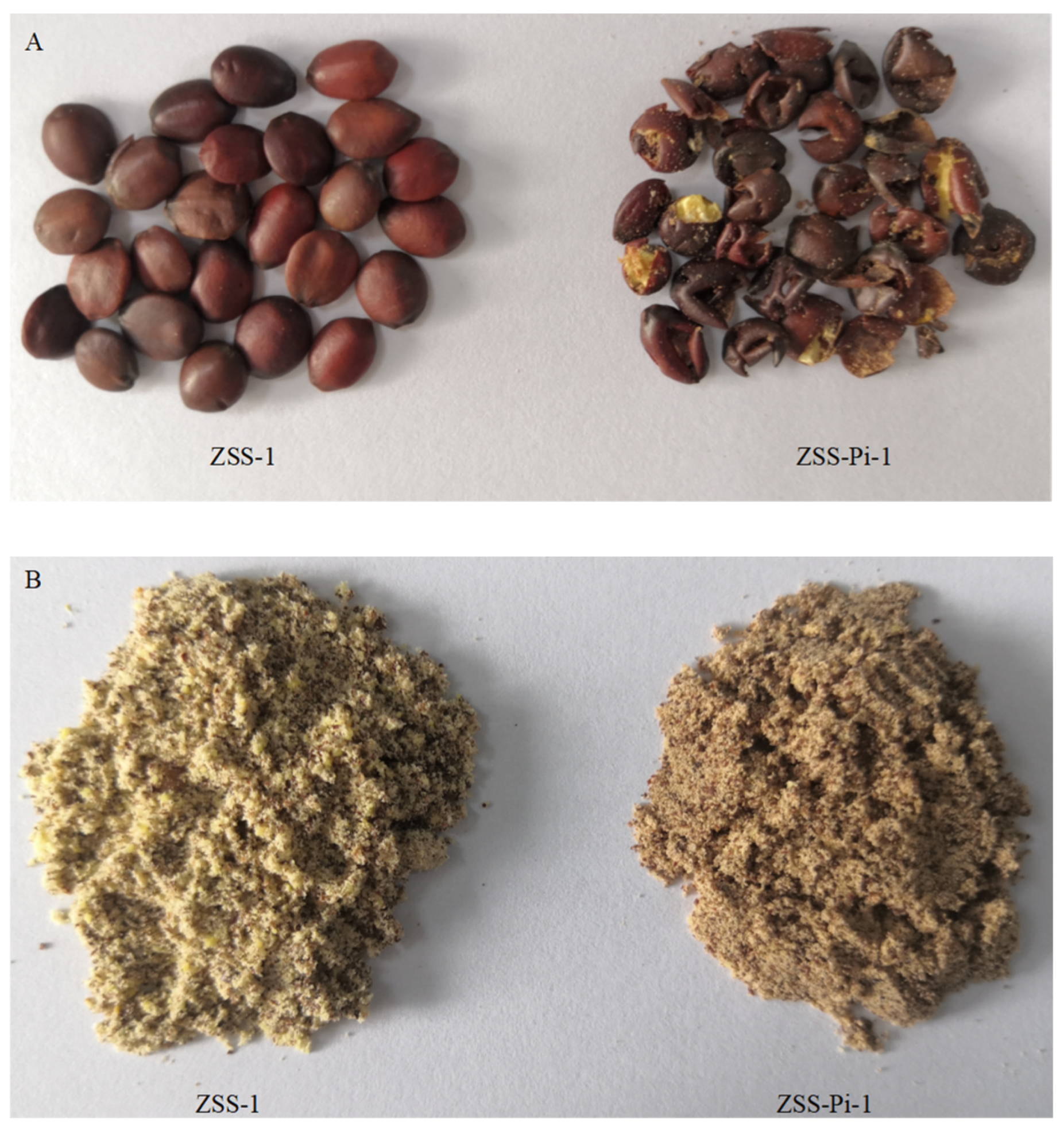

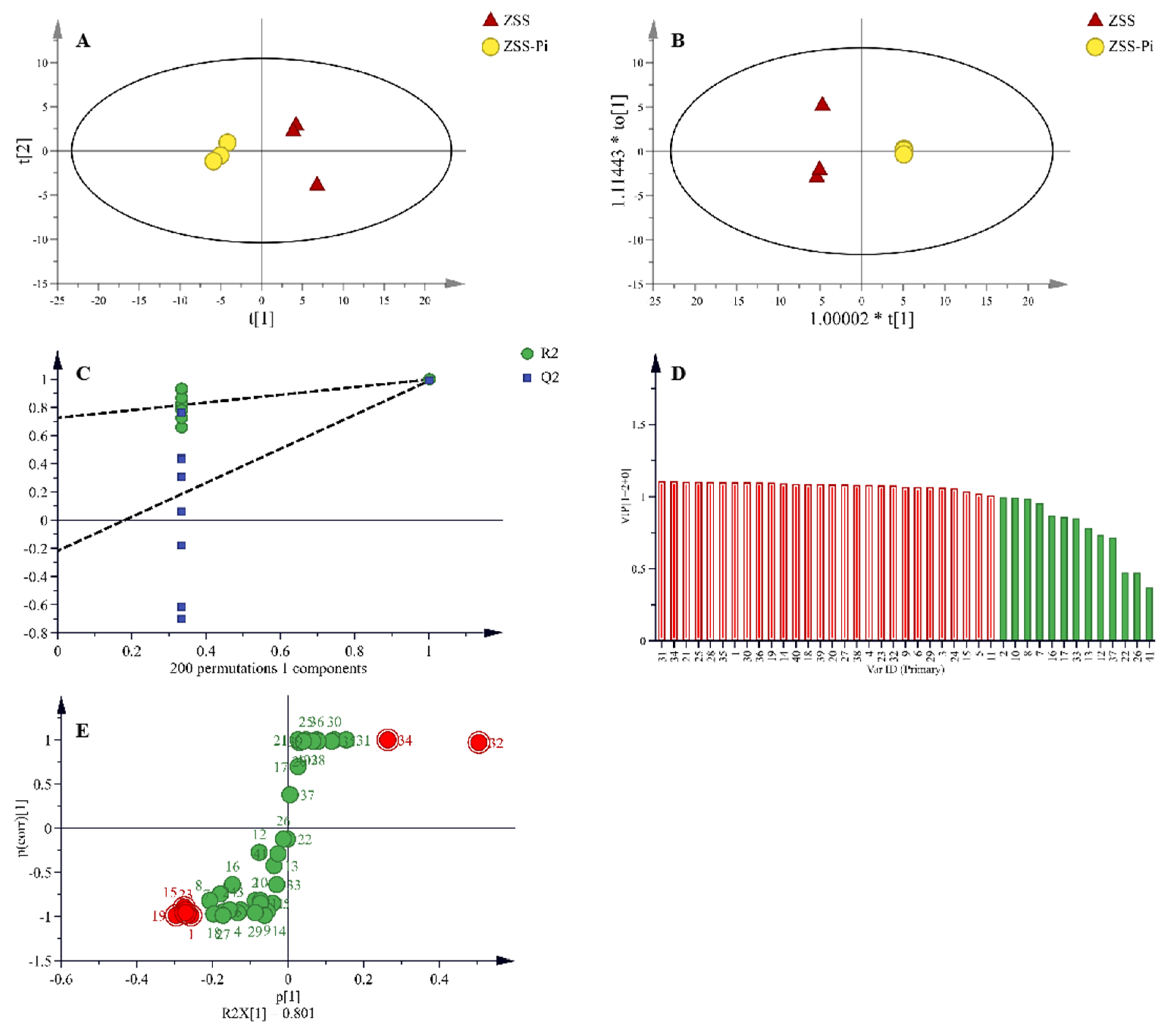
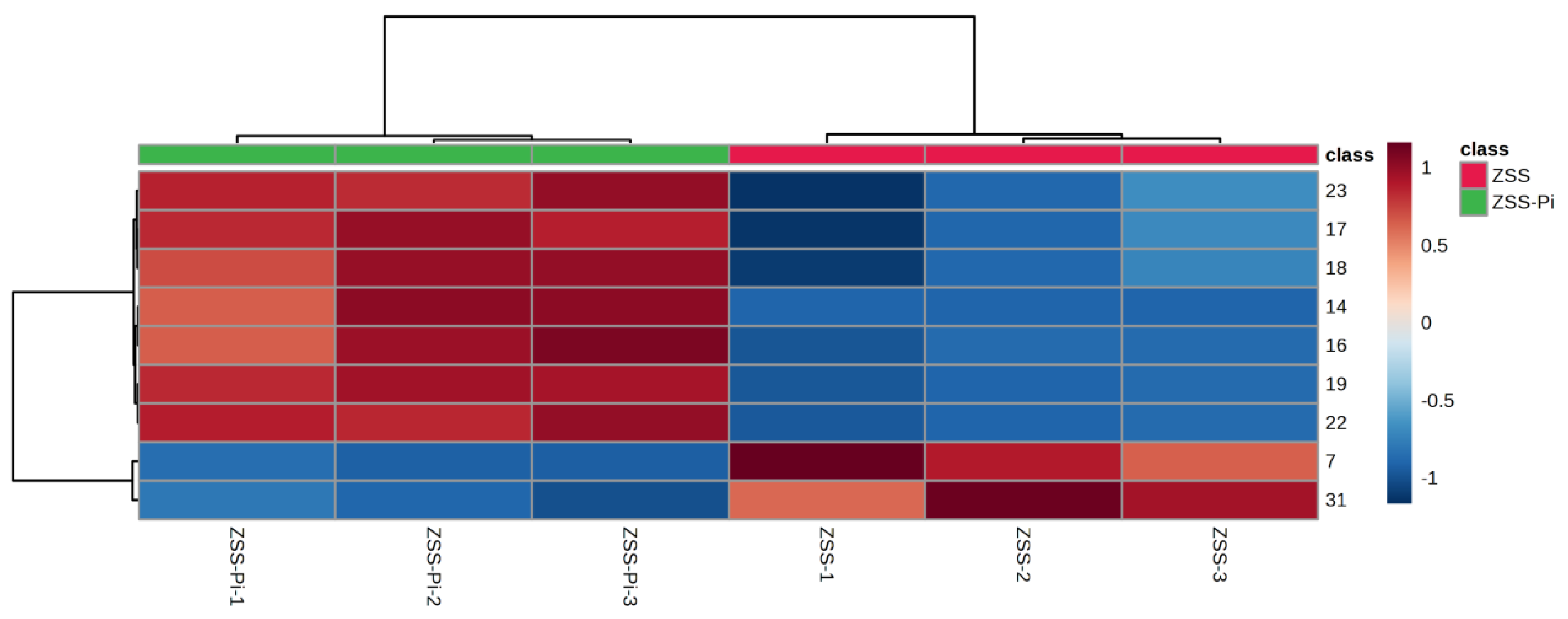
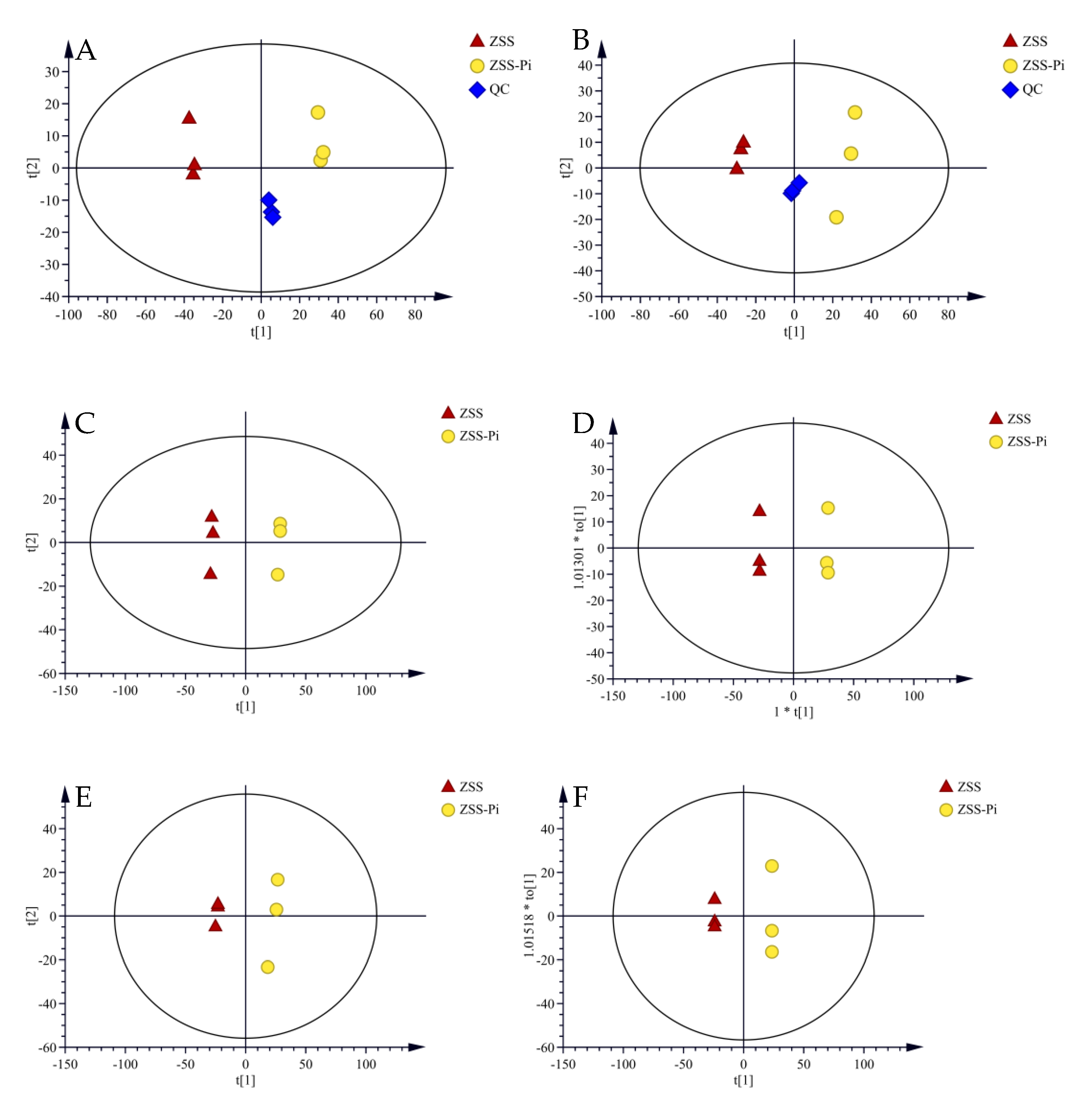
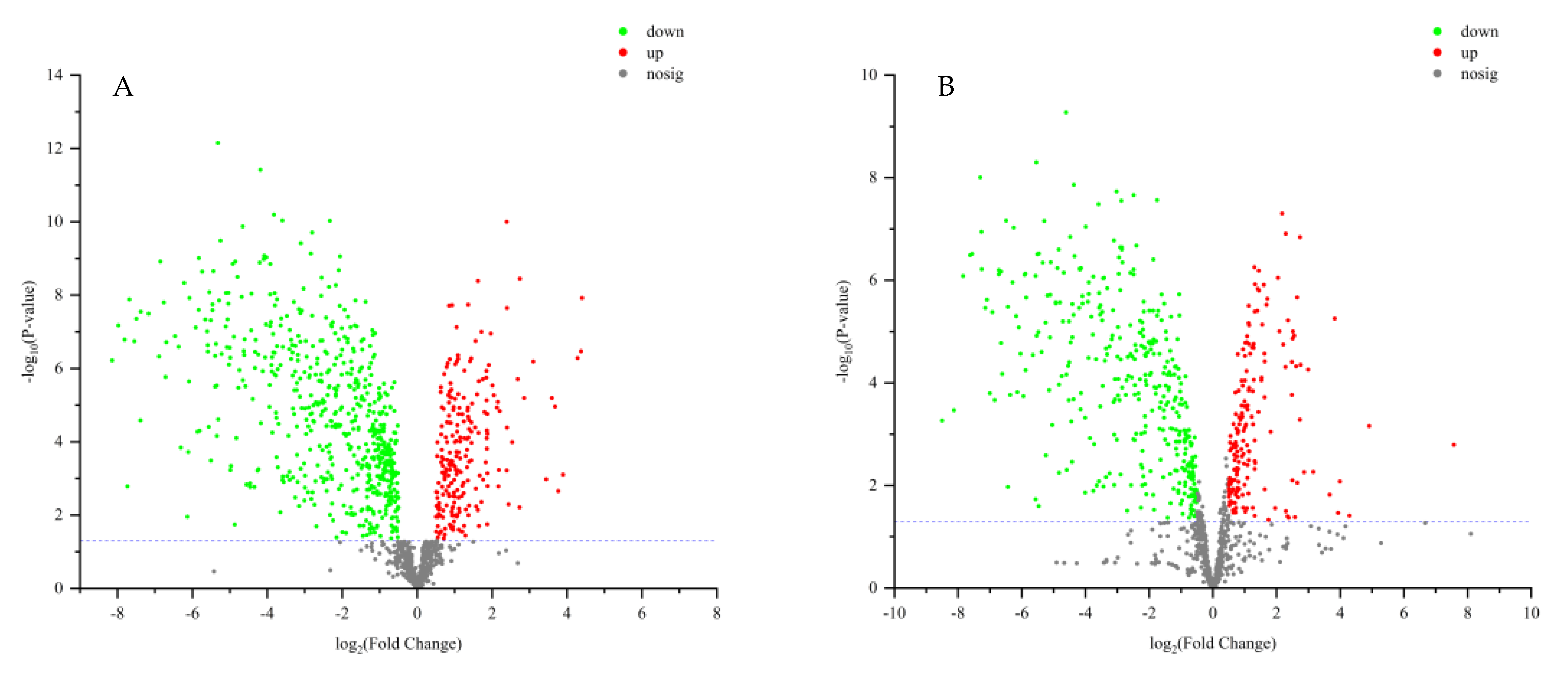
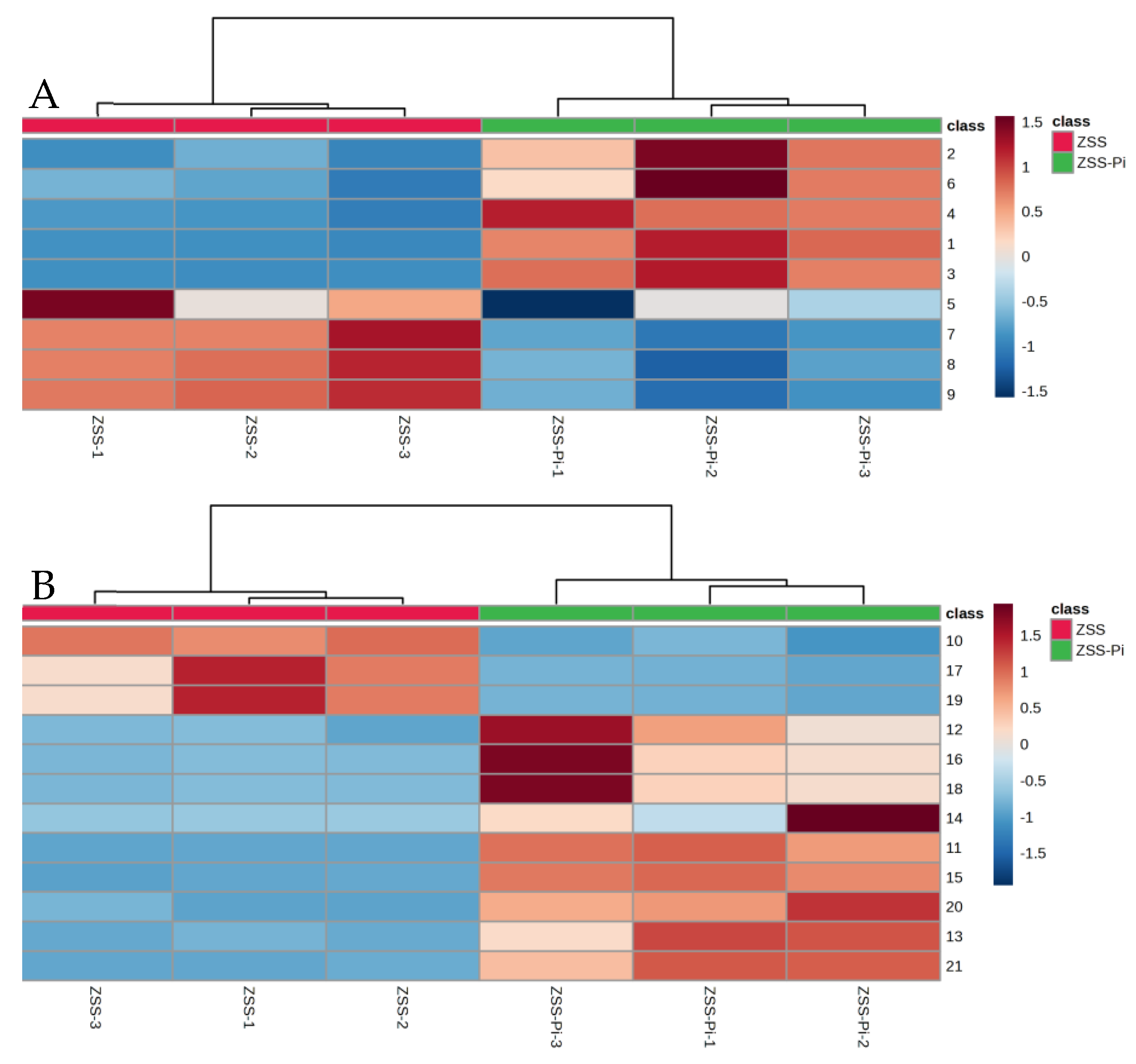
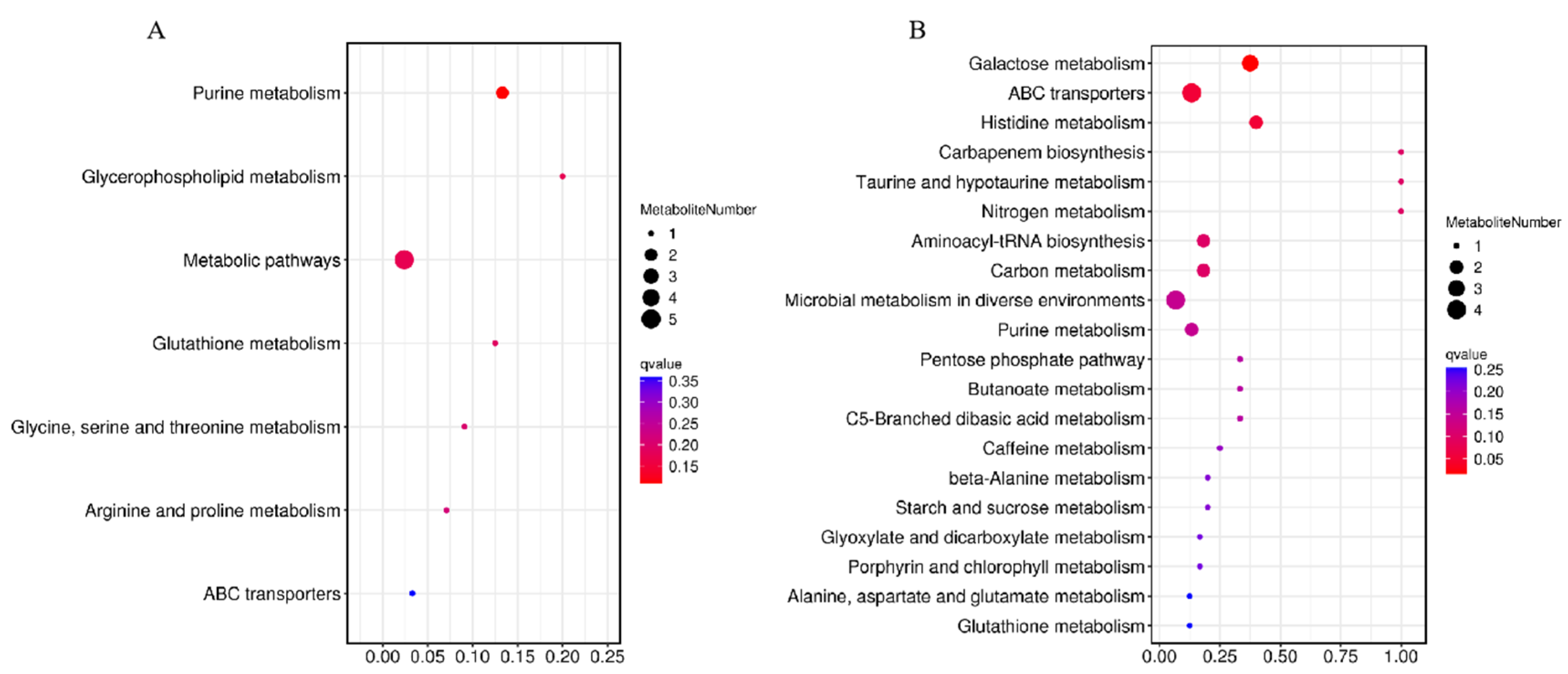
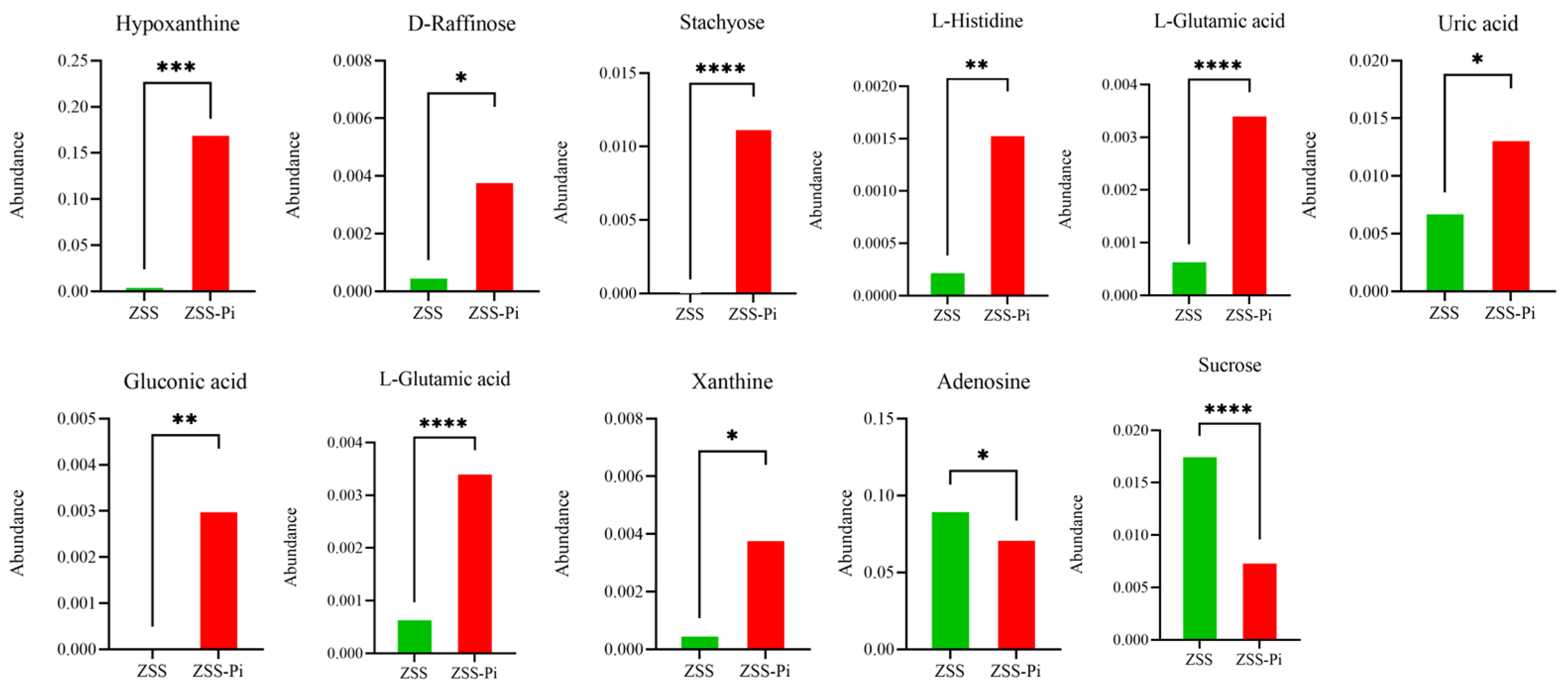
| Item | ZSS | ZSS-Pi |
|---|---|---|
| L* | 67.42 ± 1.52 * | 61.84 ± 1.00 |
| a* | 4.67 ± 0.14 | 6.39 ± 0.18 * |
| b* | 12.74 ± 0.70 * | 11.16 ± 0.21 |
| ΔE* | 29.36 ± 0.91 | 33.64 ± 0.92 * |
| TFC (mg/g) | 9.89 ± 0.97 * | 6.77 ± 0.71 |
| Spinosin (mg/g) | 1.40 ± 0.25 * | 0.97 ± 0.13 |
| Jujuboside A (mg/g) | 1.06 ± 0.18 * | 0.51 ± 0.10 |
| Jujuboside B (mg/g) | 0.67 ± 0.17 * | 0.39 ± 0.08 |
| Betulinic acid (mg/g) | 3.25 ± 0.18* | 2.77 ± 0.15 |
| Compound | Linear Equation 1 | Linear Range (μg/mL) | R2 |
|---|---|---|---|
| Spinosin | Y = 2,077,367 X + 346,638 | 27.40~2192 | 0.9998 |
| Jujuboside A | Y = 2,029,085,549 X + 7380 | 12.60~1008 | 0.9998 |
| Jujuboside B | Y = 248,640,993 X + 2455 | 12.50~1003 | 0.9996 |
| Betulinic acid | Y = 6,967,454 X + 31,766 | 13.26~1058 | 0.9999 |
Disclaimer/Publisher’s Note: The statements, opinions and data contained in all publications are solely those of the individual author(s) and contributor(s) and not of MDPI and/or the editor(s). MDPI and/or the editor(s) disclaim responsibility for any injury to people or property resulting from any ideas, methods, instructions or products referred to in the content. |
© 2025 by the authors. Licensee MDPI, Basel, Switzerland. This article is an open access article distributed under the terms and conditions of the Creative Commons Attribution (CC BY) license (https://creativecommons.org/licenses/by/4.0/).
Share and Cite
Xu, B.; Liu, Z.; Shen, Y.; Cheng, Y.; Song, P.; Wang, F.; Chao, Z. Comprehensive Analysis on Physicochemical Properties and Characteristic Compounds of Insect-Infested Ziziphi Spinosae Semen. Metabolites 2025, 15, 188. https://doi.org/10.3390/metabo15030188
Xu B, Liu Z, Shen Y, Cheng Y, Song P, Wang F, Chao Z. Comprehensive Analysis on Physicochemical Properties and Characteristic Compounds of Insect-Infested Ziziphi Spinosae Semen. Metabolites. 2025; 15(3):188. https://doi.org/10.3390/metabo15030188
Chicago/Turabian StyleXu, Bo, Zhenying Liu, Yanzhen Shen, Yunxia Cheng, Pingping Song, Feifei Wang, and Zhimao Chao. 2025. "Comprehensive Analysis on Physicochemical Properties and Characteristic Compounds of Insect-Infested Ziziphi Spinosae Semen" Metabolites 15, no. 3: 188. https://doi.org/10.3390/metabo15030188
APA StyleXu, B., Liu, Z., Shen, Y., Cheng, Y., Song, P., Wang, F., & Chao, Z. (2025). Comprehensive Analysis on Physicochemical Properties and Characteristic Compounds of Insect-Infested Ziziphi Spinosae Semen. Metabolites, 15(3), 188. https://doi.org/10.3390/metabo15030188






